Sheldon’s Trip to Nagoya, Japan
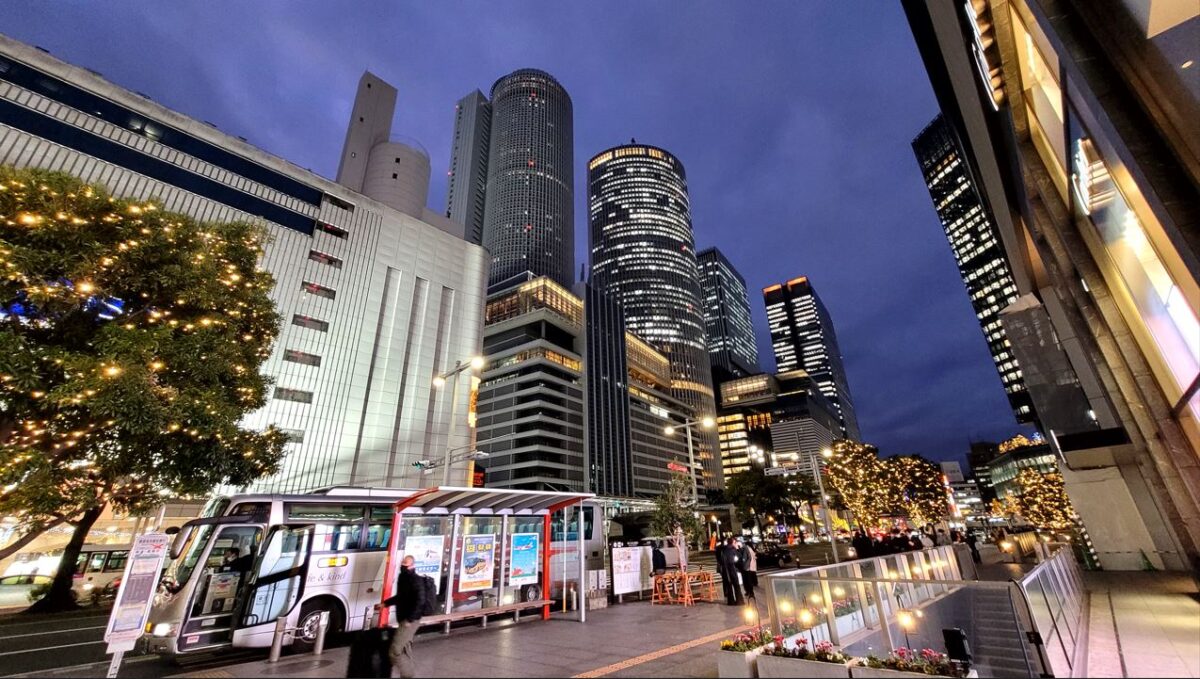
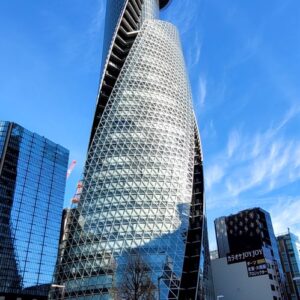
Mode Gakuen Spiral Tower Architect: Nikken Sekkei Year: 2008
Nagoya is the fourth largest city in Japan and is located in Aichi Prefecture right in the middle of the country. It’s often overlooked by travellers as not being as interesting as cities like Kyoto, Osaka, and Tokyo that are famous for their long history, food, nightlife, and pop culture. However, anyone interested in architecture, trains, Studio Ghibli, or cars may want to consider a stop by this city. You might even be surprised to find the preserved remains of one of Frank Lloyd Wright’s most famous buildings in Japan.
You’ll likely arrive in the city by train, as it is served by at least four different rail companies: Japan Rail (JR) which includes the bullet train (shinkansen), Meitetsu (a Nagoya regional train company), Kintetsu Rail (serving the Kinki region), and the Nagoya Municipal Subway. By 2027, the new MagLev train (magnetic levitation) the Chūō Shinkansen, with top speeds of 505 km/h, will decrease travel times between Nagoya and Tokyo and eventually connect to Osaka. Nagoya has a train museum displaying multiple generations of bullet trains and the proposed MagLev train for those interested in high-speed rail history and the future. All of these train lines converge at Nagoya Station and create a confusing labyrinth across multiple buildings of concourses, several malls, office buildings, and hotels owned or leasing space from the train companies. The most recognizable of these is the JR Central Towers.
Across the street is the iconic Mode Gakuen Spiral Tower, a unique take on the skyscraper characterized by its twisting exterior walls. This building is home to three vocational schools (hence the gakuen 学園 in its name
A decent walk south of the station will eventually bring you to Shirakawa Park. Two buildings located here are the Nagoya City Science Museum and the Nagoya City Art Museum (Kisho Kurokawa, 1987). The science museum features a giant silver sphere suspended between two, 7-storey blocks and houses one of the largest planetariums in the world.
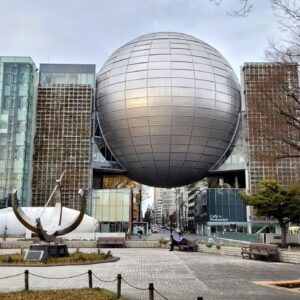
Nagoya Science Museum Architect: Nikken Sekkei Year: 1962 (Planetarium 2012)
Down the street is HASE-BLDG.1 (and HASE-BLDG.2 nearby), an interesting concrete residential building with a jagged façade. If feeling peckish, only a block away is the main store of the restaurant Yabaton selling their famous misokatsu – a breaded pork cutlet (tonkatsu) slathered in a red miso sauce the region is also famous for. You can’t miss the 6-storey restaurant – the side wall features its mascot: a giant shirtless pig.
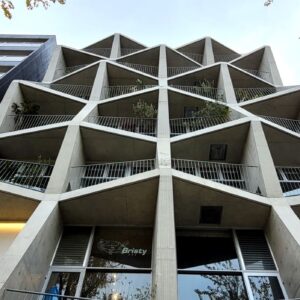
HASE-BLDG.1 Architect: C+A Coelacanth and Associates Year: 2016
If you’re interested in more historical Japanese architecture, before heading to Nagoya Castle you should stop by Nagoya City Hall and the Aichi Prefectural Government Offices. Both buildings are notable for their Japanese-style roofs on Neoclassical buildings. These are classic examples of the Imperial Crown Style popular in the 1920s and 1930s that combined aspects of Western architecture with traditional Japanese architecture. Just behind these two buildings is the Nagoya City Archives, a red brick building with bronze and black slate dome roof in a neo-Baroque style. It functioned originally as the Nagoya Court of Appeal before it eventually became the archive building.
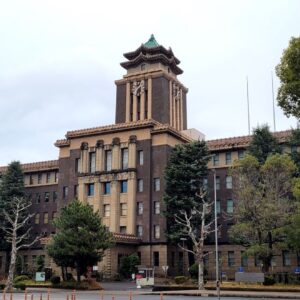
Nagoya City Hall Architect: Kingo Hirabayashi Year: 1933
Nagoya Castle
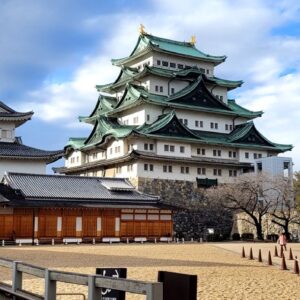
Nagoya Castle Year: 1615
The crown jewel of Nagoya is Nagoya Castle. Built in 1615 for Tokugawa Ieyasu, the first shōgun and one of three unifiers of Japan. The main building is not the original structure due to the castle being fire-bombed by the Americans during the Second World War. From 1957 onwards, the castle and several surrounding buildings have been undergoing reconstruction. The main keep features a tapering five storey building sitting on a stacked stone foundation with an inwardly curving wall. This construction technique is called “fan sloping” (ōgikōbai扇勾配), where the walls create a beautiful curve that holds back the earth inside. Each floor of the castle features a bright green copper perimeter roof typical of most castles in Japan. The topmost roof’s ridge is terminated by a pair of golden finials called Kinshachi (金鯱). The Kinshachi is a mythical fish called a shachihoko (鯱) with the head of a lion and body of a carp. The tails bend up towards the sky and were believed to store water in their belly and summon clouds and rain. They were added as protective talismans against fires, a serious issue considering most buildings in Japan were made of wood. The kinshachi is such an important symbol for Nagoya that you can find it on manhole covers, souvenir goods, and even a restaurant street near the castle called Kinshachi Alley (Kinshachi Yokochō). At the time of writing, one could not enter the keep because of ongoing construction, but one can enter the Main Palace (Honmaru Goten本丸御殿) are tatami rooms with the original fusuma screens covered in exquisite hand-painted illustrations that managed to survive the War. Some, such as in the Lord’s Audience Chamber, are covered entirely in gold leaf painted with images of tigers and pine trees covered in lichen.
Atsuta Jingū
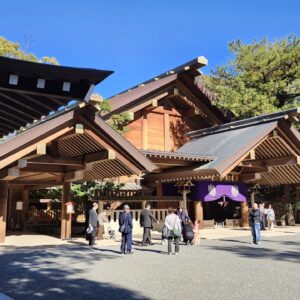
Kaguraden (神楽殿)
As Nagoya is a fairly large city without much nature, a good place to escape to for some nature and spirituality is Atsuta Jingū (熱田神宮). Atsuta Jingū is an important shrine in the indigenous religion, Shintō, and is said to house one of the tree legendary items: Kusanagi-no-tsurugi, the sword Susano-o used to vanquish the multi-headed dragon, Yamata-no-Orochi. Though it is believed to be enshrined here, only high priests and the Imperial family are permitted to witness the item. (A jingū (神宮) is a type of shrine that usually has ties to the Imperial family). The shrine is said to have been established in the 1st Century B.C.E.
It’s best practice to visit the prayer hall first to make and offering pray (expressing gratitude, rather than asking for things), before getting your goshūin (御朱印) stamp and charms, and exploring other areas of the shrine grounds. In addition to subsidiary shrines and monuments, the grounds include a treasure hall and library, as well as a pond area with an outdoor cafeteria and snack shops where one can try Nagoya’s local special noodle meal, kishimen.
Written by Sheldon DeFilippi,